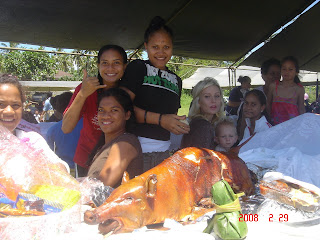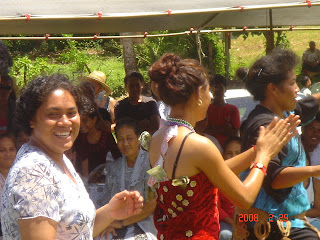The Pack
The pack was all about what was essential. The main flight allowed two 45 lb bags each, plus a couple carry-ons. The inter island light allowed up to 20 kg (44 lbs) each. One item of strong debate was about the pack-n-play, Caleb’s portable bed coming in at a whopping 22lbs. I not convinced that it was essential, but I lost that debate. We both agreed that the snorkeling gear was coming, also coming in around 22 lbs. The clothes were reduced to a few changes each and the bathroom essentials rationed out into containers.
Next item we occupied ourselves with was diapers? I was not sure if they carried disposable diapers so I informed Rachel that she need to plan on using cloth. This did not go over very well, since she has heard horror stories about cloth diapers. Relief came when I got an email from my contact that indicated that they do sell disposables.
The FlightLong… long… long. Caleb actually did very well. We got the best seats in the cabin on the plane from LAX to Tonga, right in front of the movie screen. The seats had extra leg room and there was a basinet under the screen for Caleb to sleep in.
Main Island ArrivalWe had about 4 hours before we caught our outer island plane. In LAX we met Anthony who was traveling to Nuku’alofa. He runs a program for American’s troubled youth where they get sent to foreign countries to be “reformed”. He was escorting a young man from Oklahoma.
Andrew’s offered us a ride into town where he showed us around. He took us to the bank the offered the best exchange rate, to the cell phone store where he convinced me to buy a cell phone for emergency purposes, to the ice cream shop, and then back to the airport. Andrew, if you read this, thanks!
Vava’u Finally!
The final flight on the 12 man, non-air-conditioned, twin prop plane offered spectacular views of the colorful ocean and the many tiny islands. We come in a little early and we were glad to see Sandra, the property manager, was waiting to pick us up. As she drove us into town, we received talked about the island and how to get around, but the only thing I could think of was sleep. We stopped off at a couple markets, picked up some food and headed to the house.
The House
The house is owned by an Italian. It looks like the pictures on the website, two rooms, one bath, a kitchen, living room and the Patio. The house is located atop a 50-ft cliff along the ocean which make the house all about the patio. It truly is a PARADISE VIEW. The house is surrounded by lush tropical plants and a small garden off to one side. The front has a lot of gravel for parking, and there is a short rock wall along the front and both sides. We looked around to assess what amenities we had and did not have. We do have electricity, refrigerator, phone, gas stove, microwave, running hot and cold water (the hot water was a surprise), and a couple air fans. We do not have a washer / dryer, oven, or dishwasher.
The house is located in a village called Toula, about 3 kilometers from the center of the main town Neiafu. We plan on making the trip on foot, rather than higher taxi like most tourists. The walk is 20 minutes by myself or a 35 minutes with Caleb.
The WeatherTypical tropic weather, hot and humid. So far it has been mostly sunny with an occasional overcast. I’m not sure what the temperatures, I think in the high 80’s or low 90’s. The humidity is what really makes the weather difficult to manage. Nothing is really air-conditioned; a lot of our energy is spent on figuring out how to stay cool. So far I found that a cold shower followed up by an air fan on the naked body works the best.
The AnimalsFrom what I had read on the internet and from talking to a few people, the only biologic threat we needed to be aware of was the painful bite of a centipede. No poisonous plants or animals. Since we have only been here a 1 day, we have seen lots pigs running around everywhere, chickens, in our yard, an army of ants at our front door, crickets, geckos, a tarantula, mosquitoes, starfish, sea urchins, crabs, and “the centipedes”. When we were at the domestic air terminal in Nuku’alofa, we a whole bunch of worms on the ground. Caleb started to touch them and I wasn’t too concerned… after all, I played with worms all the time when I was younger. One of the Tongans handling the baggage warned us that they were centipedes. Upon a closer look, the legs revealed themselves and we pulled Caleb away, luckily unbitten.
The Food and Water
Since we will be here for an extended period of time, we are going to cook most of our meals. Most Tongans farm a plot of land and buy very little of what they eat. The staple food is taro, sweet potatoes, yams, and other tubular roots. Tropical fruits are coconut, banana with their many variations, pineapple, watermelon, papaya, and a dozen others I have never seen before. Meats are chicken and fish, while pigs are typically saved for ceremonial dinners (weddings, holidays, etc.). Bread and eggs round it off.
All the domestic water is rainwater collected from rooftops. The rain gutters pipe rain into a concrete water tank that is located next to each house. I don’t know if the water goes through a filter before it is dispensed out faucet, but our water tastes good, especially after it is cooled.
The bananas, pineapple, and watermelon we bought from the market were as good as the ones I’ve had in the US. So far, I am not too impressed with the food yet, but I am a harsh critic and we haven’t been to any restaurants.
The CostsMost items cost more here than in the US and are imported in from Australia, China, and India. The cost of fuel is about $5.50 per gallon. I will have to adjust me budget for the trip to account for the extra expenses, since I was anticipating food grown locally would be cheap.
To follow... daily activities.
 We went to great extents to protect our food each night to keep the geckos and others from getting into, the refrigerator was the most effective. This gecko tore through the plastic bag to get at these crackers.
We went to great extents to protect our food each night to keep the geckos and others from getting into, the refrigerator was the most effective. This gecko tore through the plastic bag to get at these crackers. Rachel introduces some American Easter customs to our Tongan Family. Rachel's mom had brought some egg coloring kits and they found this to be really fascinating.
Rachel introduces some American Easter customs to our Tongan Family. Rachel's mom had brought some egg coloring kits and they found this to be really fascinating. Rachel and her mom and aunt taught many of the women in our village how to bake bread. Few of the Tongans have an oven so they used the oven at the chapel. They did this on two occasions since the women were so interested.
Rachel and her mom and aunt taught many of the women in our village how to bake bread. Few of the Tongans have an oven so they used the oven at the chapel. They did this on two occasions since the women were so interested. Feasting at the beach for Sinamoni's birthday.
Feasting at the beach for Sinamoni's birthday.
























 The baby pig our Tongan family brought to chow on
The baby pig our Tongan family brought to chow on 



